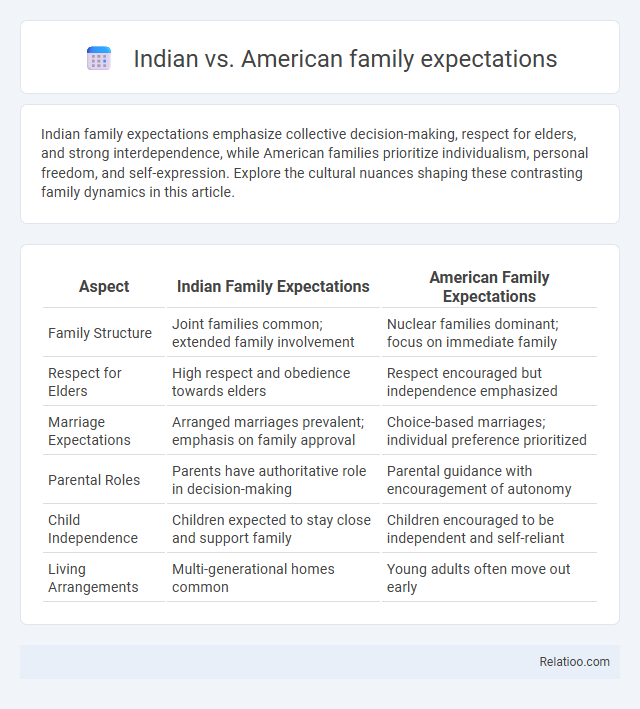Indian family expectations emphasize collective decision-making, respect for elders, and strong interdependence, while American families prioritize individualism, personal freedom, and self-expression. Explore the cultural nuances shaping these contrasting family dynamics in this article.
Table of Comparison
| Aspect | Indian Family Expectations | American Family Expectations |
|---|---|---|
| Family Structure | Joint families common; extended family involvement | Nuclear families dominant; focus on immediate family |
| Respect for Elders | High respect and obedience towards elders | Respect encouraged but independence emphasized |
| Marriage Expectations | Arranged marriages prevalent; emphasis on family approval | Choice-based marriages; individual preference prioritized |
| Parental Roles | Parents have authoritative role in decision-making | Parental guidance with encouragement of autonomy |
| Child Independence | Children expected to stay close and support family | Children encouraged to be independent and self-reliant |
| Living Arrangements | Multi-generational homes common | Young adults often move out early |
Overview of Indian vs American Family Dynamics
Indian family dynamics emphasize collectivism, with a strong focus on extended family relationships and intergenerational support, reflecting deep-rooted cultural values and social obligations. American family dynamics prioritize individualism, often centered around the nuclear family, promoting personal independence and self-reliance over collective duties. These contrasting expectations influence how family roles, responsibilities, and obligations are perceived and fulfilled within each society.
Core Values in Indian and American Households
Indian family expectations prioritize collective responsibility, respect for elders, and interdependence, emphasizing strong family obligations rooted in cultural and religious traditions. American households often value individualism, personal freedom, and self-reliance, with family obligations centered around emotional support and nurturing independence. Core values in Indian families revolve around unity and duty, while American families emphasize personal achievement and autonomy.
Parental Authority and Decision-Making
Indian family expectations emphasize strong parental authority, where parents often make key decisions regarding education, career, and marriage, reflecting deep-rooted cultural values and respect for elders. American family dynamics prioritize individual autonomy, encouraging children to make their own choices while parents offer guidance, balancing support with independence. Your understanding of these differing models impacts how you navigate family obligations and manage parental influence in decision-making processes.
Expectations Around Education and Career Choices
Indian families often emphasize high academic achievement and careers in medicine, engineering, or law, reflecting deep-rooted cultural values and societal status. American families typically encourage individual passion and diverse career paths, prioritizing personal fulfillment and self-expression over traditional prestige. Family obligation in Indian culture can include strong pressure to conform to parental expectations, while American families tend to support autonomy and independent decision-making in education and career choices.
Role of Individualism vs Collectivism
Indian family expectations emphasize collectivism, prioritizing family obligations and interdependence, where individual desires often align with group harmony and respect for elders. In contrast, American family expectations value individualism, encouraging personal autonomy and self-expression, with obligations centered on supporting oneself and nuclear family independence. These cultural differences shape family roles, decision-making, and conflict resolution, reflecting broader societal values of collective well-being versus individual rights.
Approaches to Marriage and Relationships
Indian family expectations often emphasize arranged marriages, prioritizing family honor, cultural traditions, and long-term commitment, whereas American families typically value individual choice and romantic compatibility in relationships. You may find Indian families expect strong involvement in partner selection and collective decision-making, reflecting a deep sense of family obligation, while American families encourage personal autonomy and mutual consent. These differing approaches shape how marriage and relationships are viewed, with Indian families focusing on duty and social cohesion, and American families highlighting personal happiness and freedom.
Extended Family Influence and Involvement
Indian families typically exhibit strong extended family influence, where obligations extend beyond the nuclear family to include grandparents, aunts, uncles, and cousins, reinforcing collective decision-making and caregiving responsibilities. American family expectations prioritize nuclear family independence with limited involvement from extended relatives, emphasizing individual autonomy and personal choice. The contrast highlights how Indian family structures rely on intergenerational support and communal obligations, while American families focus on self-sufficiency and boundary-setting within family roles.
Communication Styles Within Families
Indian family communication often emphasizes collectivism, with indirect expression and high-context interactions reflecting respect, hierarchy, and duty to elders, reinforcing strong family obligations. American family communication typically values individualism, directness, and low-context exchanges promoting open dialogue and personal boundaries, which shapes expectations around independence and self-expression. These contrasting styles influence how family members perceive and fulfill their roles, expectations, and responsibilities within their cultural frameworks.
Cultural Attitudes Toward Independence
Indian family expectations emphasize collective decision-making and strong family obligations, where your actions often reflect on your entire family, promoting interdependence and respect for elders. In contrast, American cultural attitudes prioritize individualism and personal independence, encouraging self-reliance and individual achievement within family dynamics. Understanding these differences highlights how cultural values shape your sense of responsibility and freedom within family relationships.
Generational Shifts in Family Expectations
Indian family expectations emphasize collective responsibility, respect for elders, and interdependence, while American families prioritize individualism, autonomy, and personal achievement. Generational shifts in India show younger members balancing traditional family obligations with modern aspirations, whereas in American families, younger generations increasingly redefine family roles, emphasizing emotional support over duty. These shifts reflect broader cultural changes, influencing how family expectations and obligations evolve across generations.

Infographic: Indian vs American family expectations
 relatioo.com
relatioo.com